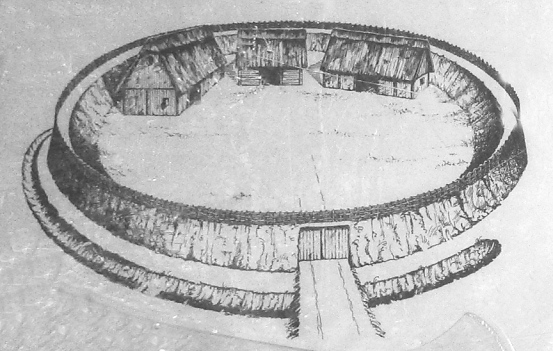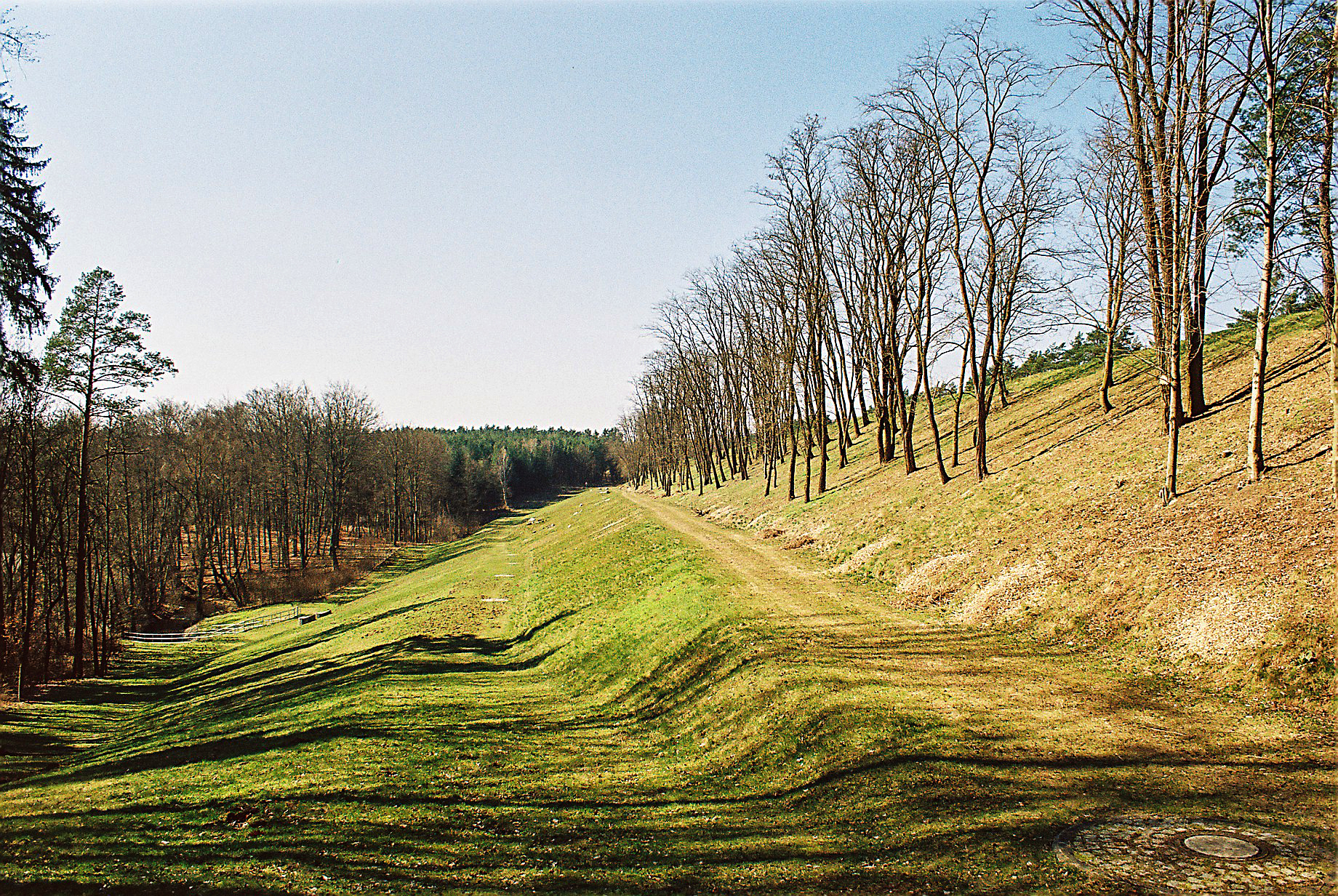|
Circular Rampart Of Burg
The circular rampart of Burg (German: ''Ringwall von Burg'') is a defensive work from the Early Middle Ages period located near the German town of Celle in Lower Saxony. The site, dating roughly to the 10th century and located in an inaccessible area of marsh by the River Fuhse, probably acted as a refuge for the local population (against Viking or Slav attacks). Today this circular embankment belongs to one of the most important Early Middle Age historical monuments in Celle. Location The circular rampart at Burg is located in the Celle suburb of Altencelle, several hundred metres west of the settlement of Burg. It is easily accessed via an improved road and a field track. Formerly this defensive work lay on a sand dune in the middle of the wide, flat valley of the Fuhse. At that time the river ran northwards past the ''Burg'', because another rampart was built to the south of the circular rampart with ditches in front of it. Today the river flows southwards past the site ... [...More Info...] [...Related Items...] OR: [Wikipedia] [Google] [Baidu] |
Ringwall Von Burg Krone
A circular rampart (German: ''Ringwall'') is an embankment built in the shape of a circle that was used as part of the defences for a military fortification, hill fort or refuge, or was built for religious purposes or as a place of gathering. The period during which these structures were built ranged from the Neolithic to the Middle Ages. Construction The key feature of a circular rampart is that the embankment formed the primary element of the defensive fortification. It can be constructed in various ways: as a simple earth embankment, as a wood and earth structure, or as a wall. Circular ramparts usually have a moat or ditch in front of them; the embankment can be enhanced with a wooden palisade. Often several concentric rings were built, which produced a more effective defensive position against attackers. The interior of such sites often shows evidence of buildings such as halls, barns, and other secondary structures. Locations Circular ramparts are found in north and west ... [...More Info...] [...Related Items...] OR: [Wikipedia] [Google] [Baidu] |
Berm
A berm is a level space, shelf, or raised barrier (usually made of compacted soil) separating areas in a vertical way, especially partway up a long slope. It can serve as a terrace road, track, path, a fortification line, a border/ separation barrier for navigation, good drainage, industry, or other purposes. Etymology The word is one of Middle Dutch and came into usage in English via French. Military use History In medieval military engineering, a berm (or berme) was a level space between a parapet or defensive wall and an adjacent steep-walled ditch or moat. It was intended to reduce soil pressure on the walls of the excavated part to prevent its collapse. It also meant that debris dislodged from fortifications would not fall into (and fill) a ditch or moat. In the trench warfare of World War I, the name was applied to a similar feature at the lip of a trench, which served mainly as an elbow-rest for riflemen. Modern usage In modern military engineering, a berm is ... [...More Info...] [...Related Items...] OR: [Wikipedia] [Google] [Baidu] |
Archaeological Sites In Germany
Archaeology or archeology is the scientific study of human activity through the recovery and analysis of material culture. The archaeological record consists of artifacts, architecture, biofacts or ecofacts, sites, and cultural landscapes. Archaeology can be considered both a social science and a branch of the humanities. It is usually considered an independent academic discipline, but may also be classified as part of anthropology (in North America – the four-field approach), history or geography. Archaeologists study human prehistory and history, from the development of the first stone tools at Lomekwi in East Africa 3.3 million years ago up until recent decades. Archaeology is distinct from palaeontology, which is the study of fossil remains. Archaeology is particularly important for learning about prehistoric societies, for which, by definition, there are no written records. Prehistory includes over 99% of the human past, from the Paleolithic until the advent o ... [...More Info...] [...Related Items...] OR: [Wikipedia] [Google] [Baidu] |
Landsknecht
The (singular: , ), also rendered as Landsknechts or Lansquenets, were Germanic mercenaries used in pike and shot formations during the early modern period. Consisting predominantly of pikemen and supporting foot soldiers, their front line was formed by ''Doppelsöldner'' ("double-pay men") renowned for their use of ''Zweihänder'' and arquebus. Originally organized by Emperor Maximilian I and Georg von Frundsberg, they formed the bulk of the Holy Roman Empire's Imperial Army from the late 1400s to the early 1600s, fighting in the Habsburg-Valois wars, the Habsburg-Ottoman wars, and the European wars of religion. Although prone to mutiny if unpaid and divided within their ranks between Catholics and Lutherans, the ''Landsknechte'' were well-armed, experienced, and fierce warriors. In addition, they were recruitable in large numbers throughout Germany and Austria by the Holy Roman Emperor and thus guaranteed both quantity and quality to the Imperial military for a century a ... [...More Info...] [...Related Items...] OR: [Wikipedia] [Google] [Baidu] |
Banditry
Banditry is a type of organized crime committed by outlaws typically involving the threat or use of violence. A person who engages in banditry is known as a bandit and primarily commits crimes such as extortion, robbery, and murder, either as an individual or in groups. Banditry is a vague concept of criminality and in modern usage can be synonymous for gangsterism, brigandage, marauding, and thievery. Definitions The term ''bandit'' (introduced to English via Italian around 1590) originates with the early Germanic legal practice of outlawing criminals, termed ''*bannan'' (English ban). The legal term in the Holy Roman Empire was ''Acht'' or ''Reichsacht'', translated as "Imperial ban". In modern Italian, the equivalent word "bandito" literally means banned or a banned person. The New English Dictionary on Historical Principles (NED) defined "bandit" in 1885 as "one who is proscribed or outlawed; hence, a lawless desperate marauder, a brigand: usually applied to members of ... [...More Info...] [...Related Items...] OR: [Wikipedia] [Google] [Baidu] |
Thirty Years War
The Thirty Years' War was one of the longest and List of wars and anthropogenic disasters by death toll, most destructive conflicts in History of Europe, European history, lasting from 1618 to 1648. Fought primarily in Central Europe, an estimated 4.5 to 8 million soldiers and civilians died as a result of battle, famine, and disease, while some areas of what is now modern Germany experienced population declines of over 50%. Related conflicts include the Eighty Years' War, the War of the Mantuan Succession, the Franco-Spanish War (1635–1659), Franco-Spanish War, and the Portuguese Restoration War. Until the 20th century, historians generally viewed it as a continuation of the religious struggle initiated by the 16th-century Reformation within the Holy Roman Empire. The 1555 Peace of Augsburg attempted to resolve this by dividing the Empire into Lutheranism, Lutheran and Catholic Church, Catholic states, but over the next 50 years the expansion of Protestantism beyond these ... [...More Info...] [...Related Items...] OR: [Wikipedia] [Google] [Baidu] |
Hermann Löns
Hermann Löns (29 August 1866 – 26 September 1914) was a German journalist and writer. He is most famous as "The Poet of the Heath" for his novels and poems celebrating the people and landscape of the North German moors, particularly the Lüneburg Heath in Lower Saxony. Löns is well known in Germany for his famous folksongs. He was also a hunter, natural historian and conservationist. Despite being well over the normal recruitment age, Löns enlisted and was killed in World War I and his purported remains were later used by the German government for celebratory purposes. Life and work Hermann Löns was born on 29 August 1866 in Kulm (now Chełmno, Poland) in West Prussia. He was one of twelve siblings, of whom five died early. His parents were Friedrich Wilhelm Löns (1832–1908) from Bochum, a teacher, and Klara (née Cramer; 1844–96) from Paderborn. Hermann Löns grew up in Deutsch-Krone (West Prussia). In 1884, the family relocated back to Westfalen as his fathe ... [...More Info...] [...Related Items...] OR: [Wikipedia] [Google] [Baidu] |
Stone Age
The Stone Age was a broad prehistoric period during which stone was widely used to make tools with an edge, a point, or a percussion surface. The period lasted for roughly 3.4 million years, and ended between 4,000 BC and 2,000 BC, with the advent of metalworking. Though some simple metalworking of malleable metals, particularly the use of gold and copper for purposes of ornamentation, was known in the Stone Age, it is the melting and smelting of copper that marks the end of the Stone Age. In Western Asia, this occurred by about 3,000 BC, when bronze became widespread. The term Bronze Age is used to describe the period that followed the Stone Age, as well as to describe cultures that had developed techniques and technologies for working copper alloys (bronze: originally copper and arsenic, later copper and tin) into tools, supplanting stone in many uses. Stone Age artifacts that have been discovered include tools used by modern humans, by their predecessor species in the ... [...More Info...] [...Related Items...] OR: [Wikipedia] [Google] [Baidu] |
Flint
Flint, occasionally flintstone, is a sedimentary cryptocrystalline form of the mineral quartz, categorized as the variety of chert that occurs in chalk or marly limestone. Flint was widely used historically to make stone tools and start fires. It occurs chiefly as nodules and masses in sedimentary rocks, such as chalks and limestones.''The Flints from Portsdown Hill'' Inside the nodule, flint is usually dark grey, black, green, white or brown in colour, and often has a glassy or waxy appearance. A thin layer on the outside of the nodules is usually different in colour, typically white and rough in texture. The nodules can often be found along s and |
Carl Schuchhardt
Carl Schuchhardt (August 6, 1859 – December 7, 1943) was a German archaeologist and museum director. For many years, he was the director of the pre-historic department of the Ethnological Museum of Berlin. He was involved in numerous excavations, both in Europe and the Middle East, and contributed significantly to archaeological science. In his time, he was seen as Germany's most senior and accomplished prehistorian. Life and early career Carl Schuchhardt was born in Hanover, Germany, in 1859 as the eldest of four children of a prominent local copper engraver and graphic artist. After completing school in Vegesack, Schuchhardt studied classical philology, modern languages and archaeology in Leipzig, Göttingen and Heidelberg. After 1883 he worked briefly as a teacher in Konstanz and Karlsruhe before taking a position as private tutor to the young sons of Romanian prince Alexander Bibescu. His time in Romania allowed him to study the many earthwork fortifications in the Dobrogea a ... [...More Info...] [...Related Items...] OR: [Wikipedia] [Google] [Baidu] |
Early Middle Ages
The Early Middle Ages (or early medieval period), sometimes controversially referred to as the Dark Ages, is typically regarded by historians as lasting from the late 5th or early 6th century to the 10th century. They marked the start of the Middle Ages of European history, following the decline of the Western Roman Empire, and preceding the High Middle Ages ( 11th to 13th centuries). The alternative term ''late antiquity'', for the early part of the period, emphasizes elements of continuity with the Roman Empire, while ''Early Middle Ages'' is used to emphasize developments characteristic of the earlier medieval period. The period saw a continuation of trends evident since late classical antiquity, including population decline, especially in urban centres, a decline of trade, a small rise in average temperatures in the North Atlantic region and increased migration. In the 19th century the Early Middle Ages were often labelled the ''Dark Ages'', a characterization based on t ... [...More Info...] [...Related Items...] OR: [Wikipedia] [Google] [Baidu] |


.jpg)


.jpg)



